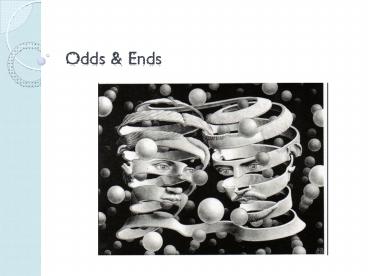Odds - PowerPoint PPT Presentation
Title:
Odds
Description:
Title: Chapter 7 Author: Chrystal McChristian Last modified by: Michele Created Date: 7/14/2006 7:27:50 PM Document presentation format: On-screen Show (4:3) – PowerPoint PPT presentation
Number of Views:122
Avg rating:3.0/5.0
Title: Odds
1
Odds Ends
2
The Vestibular Sense
- The sense responsible for maintaining balance.
- Enables us to walk on two feet, keep our head
upright, and adjust our eye movements to
compensate for our head movements.
Phillippe Petit
3
(No Transcript)
4
Motion Sickness
- Feelings of dizziness and nausea occur when the
body is moved passively without motor activity
and corresponding feedback to the brain. - Two types of motion sickness
- Detects movements but motor actions that could
have produced the movement have not occurred - Detects movement
- inconsistent with the
- information about movement
- sensed by the eyes
5
The Somatosenses
- The skin sensations of touch, pain, temperature.
- The functions of the skin include
- protecting the internal organs from injury
- helping regulate body temperature by producing
sweat, which cools the body when it becomes too
hot - providing a first line of defense against
invading microorganisms.
6
Skin Receptors
7
Skin ReceptorsGlabrous Skin
8
The Experience and Control of Pain
- Pain has both negative and positive functions
- Chronic pain can be the bane of a persons
existence. - However, under ordinary circumstances, pain is
extremely useful, warning us of potential injury
and inducing us to seek appropriate treatment.
9
Theories of Pain
- Melzack Wall (1965)
- Gate-control theory of pain - Input from pain
receptors will produce the perception of pain
only if the message first passes through a gate
in the spinal cord and lower brain stem
structures. - Melzak (1999)
- Neuromatrix theory of pain accounts for types
of pain unexplained by the gate-control theory of
pain.
10
Gate-Control Theory of Pain
11
The Chemical Senses
- Chemical senses include the gustatory and
olfactory systems. - Both are intermingled in our eating experiences,
in that much of what we report as the taste of
food actually comes from its odor. - Flavor -
- Touch plays a role crisp/soggy, mushy
- And visual cues green, slimy
- Also temperature cold eggs, warm milk
12
Taste and Smell
13
Genetics of Taste
- People differ in their sensitivity to bitter and
some sweet tastes. - These individual differences appear to be partly
related to the number of taste buds on the
tongue - Supertasters (25 of people) have the most taste
buds - about 425 per square cm on the tongue tip. - Medium tasters (50 of people) have about 184
taste buds per square cm. - Non-tasters (25 of people) have about 96 per
square cm.
14
Power Naps
- Just one 26 minute power nap can increase your
cognitive skills by 40 percent - Prime napping time falls in the middle of the
day, between 1 p.m. and 3 p.m.
15
Power Naps
- Ben and Jerrys
- British Airways
- Pizza Hut
- Proctor Gamble
- Story











![download⚡[PDF]❤ Texas Hold'em Odds and Probabilities PowerPoint PPT Presentation](https://s3.amazonaws.com/images.powershow.com/10053525.th0.jpg?_=202406121211)



![⚡[PDF]✔ How to Play Craps with the Best Odds of Winning: The Ultimate Guide to Craps, PowerPoint PPT Presentation](https://s3.amazonaws.com/images.powershow.com/10058754.th0.jpg?_=20240619081)















